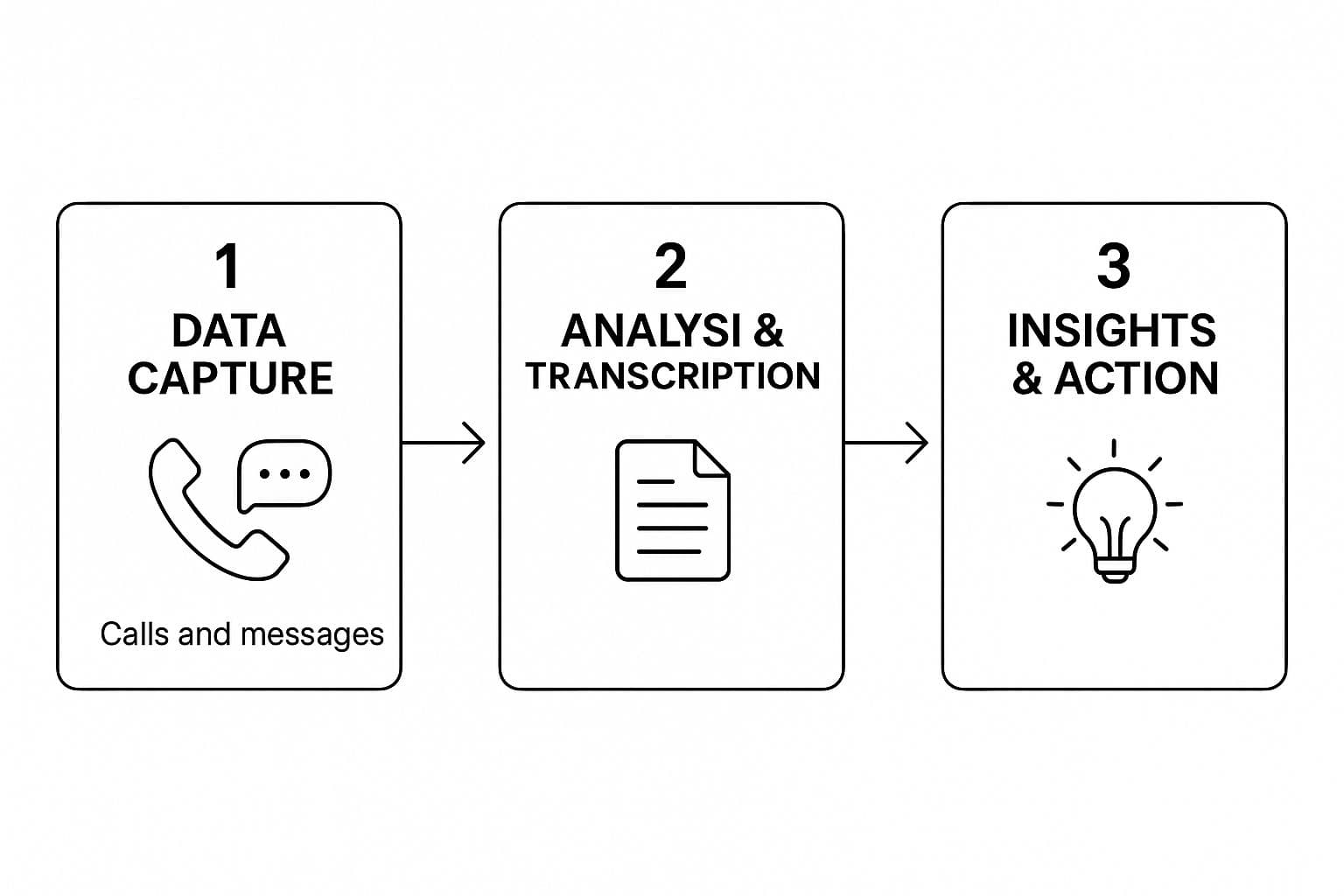Think of conversation intelligence as a game-tape review for your business. Just like a sports team pores over footage to see what plays led to a win, this technology uses AI to record, transcribe, and analyze your team's calls with customers. It's all about turning everyday conversations into a playbook for success.
What Is Conversation Intelligence in Simple Terms
Imagine you could be a fly on the wall for every single sales call or customer support chat. Not to breathe down anyone's neck, but to genuinely understand what makes your best people so good. That's the essence of what is conversation intelligence (CI).
It's a system built to capture the unfiltered voice of your customer right from the source—your frontline interactions. No more relying on hazy memories, scribbled notes, or the time-consuming chore of manual call reviews. CI platforms automatically pull in conversations from video meetings, phone calls, and even emails, giving you the full picture.

From Raw Conversation to Strategic Insight
So, how does it all work? The process is surprisingly simple but incredibly powerful. First, a CI tool captures and transcribes the conversation with a high degree of accuracy. From there, it uses sophisticated tech like Natural Language Processing (NLP) to make sense of the text. This is similar to the technology behind many popular transcription services, which you can learn more about in our guide on what is Otter.ai.
The platform automatically sifts through the conversation to find the gold, highlighting things like:
- Key Topics: It pinpoints every time pricing, a competitor's name, or a specific product feature comes up.
- Action Items: Any mention of a follow-up task gets flagged, so nothing ever slips through the cracks.
- Customer Sentiment: The system can detect the emotional tone, letting you know if a customer is thrilled or frustrated.
- Talk Patterns: It even measures the talk-to-listen ratio, helping you see if your reps are truly listening or just talking at the customer.
To break it down, CI platforms generally operate on a four-step process to turn raw audio into a strategic asset.
The Four Pillars of Conversation Intelligence
This table outlines the fundamental process CI platforms use to transform raw conversations into strategic business assets.
By following these steps, CI turns messy, unstructured conversations into clean, structured data.
Ultimately, this technology hands your teams a searchable library of every single customer interaction. It takes the guesswork out of the equation. Managers can coach with precision, marketers can fine-tune their messaging, and every sales rep can learn directly from the company's most successful calls. It’s all about learning from your most valuable asset: your customer conversations.
How the Technology Actually Works
So, how does a platform manage to "listen" to thousands of conversations at once and actually make sense of them? It’s not magic, but a smart blend of a few different AI technologies working together.
It all starts with data capture. The software plugs into the tools you already use—like Zoom, phone systems, or email—to record the audio and text from your customer interactions. This is the raw material.
Next up is speech recognition. This is the part that painstakingly converts all that recorded audio into a written transcript. It turns spoken words into structured text that a computer can actually read and analyze. Once everything is in text form, the real intelligence kicks in.
The Brains of the Operation
The core of this whole process is Natural Language Processing (NLP). Think of NLP as a super-intelligent assistant that doesn’t just see words on a page but actually grasps their meaning, the context they’re used in, and even the emotion behind them. This is the key difference between a conversation intelligence platform and a simple call recorder.
This is the tech that allows the platform to do the really cool stuff, like:
- Topic Identification: Automatically spotting when a competitor's name, pricing, or a key product feature is mentioned.
- Sentiment Analysis: Figuring out the emotional tone of a call to see if a customer is happy, frustrated, or confused.
- Action Item Detection: Catching and flagging any follow-up tasks or promises made during a conversation so nothing falls through the cracks.
The image below gives a simple, three-step look at how this works.

This flow really just shows how everyday interactions get turned into concrete business insights.
Finding Patterns with Machine Learning
Finally, machine learning algorithms sift through all this data, looking for patterns across thousands of conversations. The market for this technology has exploded; the global conversation intelligence platform market was valued at $1.685 billion in 2025 and is projected to climb much higher. You can see more details on the growth of conversation intelligence platforms.
The system is always learning. The more conversations it analyzes, the smarter it gets at pulling out accurate, high-quality insights. It's like turning your team's daily calls into a playbook for success that updates itself in real-time.
What This Actually Means for Your Teams
The technology behind conversation intelligence is impressive, but what really matters are the day-to-day results it brings to your teams on the front lines. For sales teams, it’s like having a game film for every single call.

Think about it: a sales manager can finally listen in and find the exact moments where top reps work their magic to close a deal. They can then take these "greatest hits" and build a playbook of what actually works, turning coaching from a guessing game into a data-driven science.
A Game-Changer for Sales Performance
The impact on sales is direct and easy to see. By analyzing the tone, sentiment, and engagement levels in a sales call, managers can get a much clearer picture of how a deal is really going. You're no longer just relying on a salesperson's gut feeling.
This leads to some huge advantages:
- Real-World Coaching: You can point to specific moments in a call—like when a rep handled an objection perfectly—and use it as a teaching moment.
- Get New Hires Up to Speed Faster: Instead of just theory, new reps can listen to a curated playlist of winning calls and learn the ropes in record time.
- Keep Everyone on the Same Page: It ensures the whole team is using the same proven messaging and positioning.
Many of these perks are similar to what you’ll find in the best AI meeting assistant tools, but CI platforms dig much deeper into sales-specific metrics and team-wide trends.
A Boost for Customer Service and Support
The story is just as compelling for customer service teams. Conversation intelligence acts as a quality control supervisor that never sleeps, helping standardize the level of support every customer receives.
Beyond quality assurance, it's also an incredible early-warning system. The software can spot recurring complaints or questions across thousands of customer interactions, flagging trends long before they become massive problems. This helps support teams move from just reacting to individual tickets to proactively improving the entire customer experience.
Real-World Examples of CI in Action
Okay, the theory is great, but let's talk about what this actually looks like on the ground. It’s one thing to define conversation intelligence, but seeing it in action is when the lightbulb really goes on.
Let's look at a few practical scenarios where companies are turning everyday customer chats into a serious competitive edge.
Nailing the Marketing Message
Imagine a B2B SaaS company that’s burning cash on ad copy that just isn't landing. Instead of throwing more guesses at the wall, they turn to their conversation intelligence tool.
The platform dives into hundreds of initial discovery calls, pulling out the exact words and phrases prospects use to describe their biggest headaches. Suddenly, the marketing team has a goldmine of unfiltered customer language. They can build entire campaigns using the precise terminology their ideal customers use, which leads to way more engagement and much better leads.
Getting Ahead of Customer Issues
Here’s another one: a customer support manager notices a small but definite rise in frustrated callers. She can’t quite put her finger on why.
She uses her CI platform to scan support call transcripts, and it immediately flags a recurring, subtle mention of a bug in their latest software update. Customers weren't officially reporting it, but the pattern was there. This insight allows her to give the product team a heads-up, and they fix the bug before it escalates into a full-blown crisis.
The growth in this space is staggering. The global conversational AI market, which is a close cousin to conversation intelligence, was valued at USD 12.24 billion in 2024. It’s projected to soar to nearly USD 61.7 billion by 2032. You can dive deeper into this trend over at Fortune Business Insights.
Cloning Your Best Sales Rep
Finally, think about a sales leader who wishes she could clone her top performer. Instead of just offering vague advice to the rest of the team, she uses CI to analyze that star rep's calls.
She creates a "greatest hits" playlist of their best moments—specifically, how they handle tough objections. This playlist becomes a powerful training tool, giving every single rep a clear, real-world model for what success sounds like.
How to Choose the Right Conversation Intelligence Platform for You
Picking the right conversation intelligence platform is a big decision, and honestly, not all of them are created equal. The goal isn't just to buy software; it's to find a tool that actually fits into how your team works and gives them the specific insights they need to get better.

So, where do you start? Begin with the basics. How good is the transcription? If it’s constantly making mistakes, you can’t trust the data. And critically, does it play nicely with the tools you already use every day, like your CRM?
A smooth integration with platforms like Salesforce or HubSpot is a deal-breaker. You need a system that automatically logs call data without making your reps do a bunch of manual data entry. To see how this works in practice, you can read our guide on how AI meeting tools integrate with CRM systems.
Comparing Conversation Analysis Tools
To find the right fit, it helps to understand the key differences between the types of tools out there. Are you just looking to record calls, or do you need deep, actionable insights? This table breaks down the landscape, from basic call recording to full-featured Conversation Intelligence platforms.
As you can see, the right choice really depends on your specific goals. While a simple summarizer is great for productivity, a true CI platform is built to drive revenue and improve performance across the entire team.
Key Features to Look For
Once you move beyond basic recording, the depth of the analytics is what really makes a difference. A great platform doesn't just record what was said; it tells you what it all means.
Look for these game-changing features:
- Topic & Keyword Tracking: Does the tool automatically flag every time a competitor is mentioned? What about pricing objections or specific product features? This is huge.
- Sentiment Analysis: You need a way to gauge the emotional temperature of a call. Was the customer excited, frustrated, or indifferent? This context is pure gold.
- Action Item Detection: How many follow-ups get missed? A good CI tool automatically finds and lists out action items so nothing ever falls through the cracks again.
- Coaching Capabilities: This is where the magic happens for managers. Look for tools that let you bookmark key moments in a call, add comments, and share them with your reps for targeted feedback.
The demand for this technology is exploding for a reason. In North America alone, the conversation intelligence market shot past $9.3 billion in 2024, which shows just how many companies are relying on AI to find their competitive edge. You can dig into the numbers in this conversation intelligence software market report.
Ultimately, choosing a platform is about investing in a partner that can give you the clarity you need to scale your team and your business.
Got Questions About Conversation Intelligence? We’ve Got Answers.
As teams start to dig into conversation intelligence, a few key questions almost always pop up. Let's tackle the big ones—the legal, financial, and technical details you need to know before you dive in.
Is This Stuff Legal and Ethical?
Absolutely, as long as you're open about it. The golden rule here is transparency and consent.
These tools are built for internal coaching and making your team better, not for spying on people. The most important thing is to follow all recording laws. Some places require "two-party consent," which just means you have to clearly tell everyone on the call that it's being recorded and analyzed.
What’s the Price Tag on These Platforms?
The cost can be all over the map, depending on what you need. Most platforms charge per user, per month.
A basic AI summarizer might not cost much at all. But if you’re looking for a full-blown system with deep analytics that plugs into your CRM and offers advanced coaching tools, you're looking at a more significant investment.
The final price usually boils down to a few things:
- How many people on your team need access?
- How detailed do you need the analytics and reports to be?
- How many other tools (like your CRM) do you need it to connect with?
Do These Tools Get Different Languages?
For global teams, this is a huge deal. The good news is that many of the top conversation intelligence platforms are great with multiple languages.
But—and this is a big but—not all tools are created equal. When you're shopping around, you have to check exactly which languages, dialects, and even accents the software can handle. Make sure it can accurately understand your team and your customers before you commit.